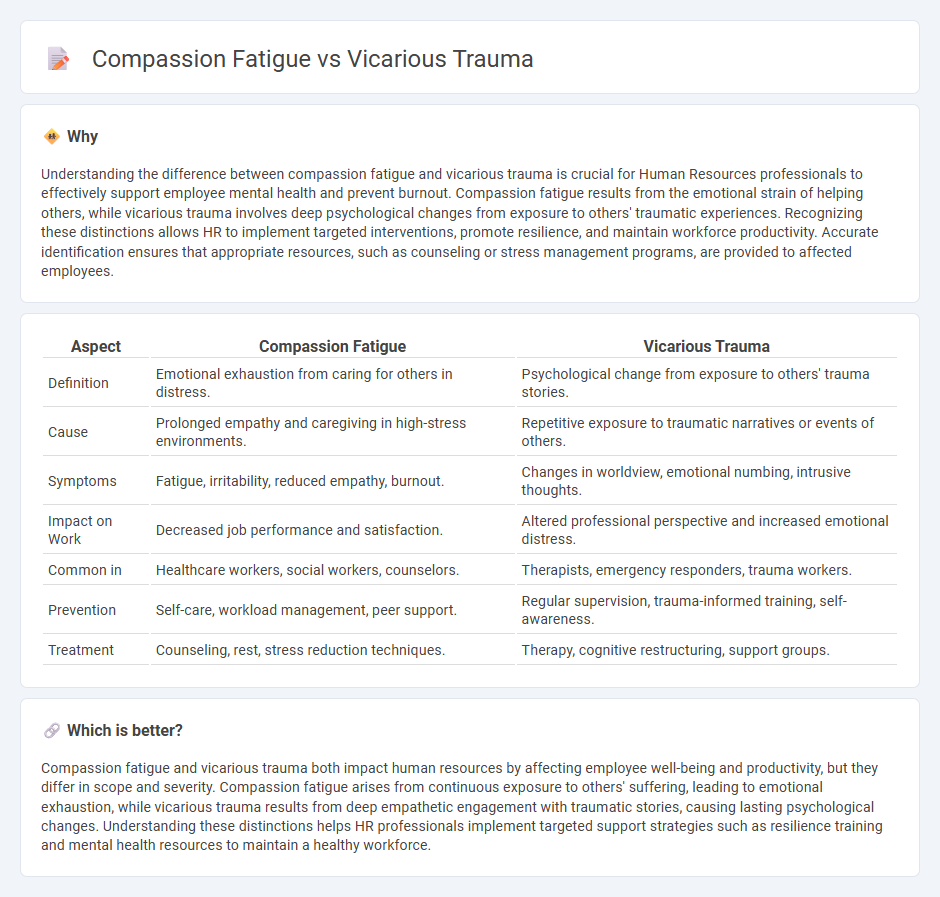
Compassion fatigue and vicarious trauma significantly impact Human Resources professionals managing employee well-being and mental health programs. Compassion fatigue arises from prolonged exposure to others' suffering, leading to emotional exhaustion, while vicarious trauma results from deep empathetic engagement with trauma survivors, altering one's worldview. Explore effective strategies to support HR teams and foster resilience in the workplace.
Why it is important
Understanding the difference between compassion fatigue and vicarious trauma is crucial for Human Resources professionals to effectively support employee mental health and prevent burnout. Compassion fatigue results from the emotional strain of helping others, while vicarious trauma involves deep psychological changes from exposure to others' traumatic experiences. Recognizing these distinctions allows HR to implement targeted interventions, promote resilience, and maintain workforce productivity. Accurate identification ensures that appropriate resources, such as counseling or stress management programs, are provided to affected employees.
Comparison Table
| Aspect | Compassion Fatigue | Vicarious Trauma |
|---|---|---|
| Definition | Emotional exhaustion from caring for others in distress. | Psychological change from exposure to others' trauma stories. |
| Cause | Prolonged empathy and caregiving in high-stress environments. | Repetitive exposure to traumatic narratives or events of others. |
| Symptoms | Fatigue, irritability, reduced empathy, burnout. | Changes in worldview, emotional numbing, intrusive thoughts. |
| Impact on Work | Decreased job performance and satisfaction. | Altered professional perspective and increased emotional distress. |
| Common in | Healthcare workers, social workers, counselors. | Therapists, emergency responders, trauma workers. |
| Prevention | Self-care, workload management, peer support. | Regular supervision, trauma-informed training, self-awareness. |
| Treatment | Counseling, rest, stress reduction techniques. | Therapy, cognitive restructuring, support groups. |
Which is better?
Compassion fatigue and vicarious trauma both impact human resources by affecting employee well-being and productivity, but they differ in scope and severity. Compassion fatigue arises from continuous exposure to others' suffering, leading to emotional exhaustion, while vicarious trauma results from deep empathetic engagement with traumatic stories, causing lasting psychological changes. Understanding these distinctions helps HR professionals implement targeted support strategies such as resilience training and mental health resources to maintain a healthy workforce.
Connection
Compassion fatigue and vicarious trauma are interconnected phenomena affecting Human Resources professionals who regularly engage with employee distress and organizational crises. Both result from prolonged exposure to others' emotional suffering, leading to diminished empathy, emotional exhaustion, and decreased job performance. Addressing these issues through targeted interventions, such as resilience training and mental health support, is crucial to maintain workforce well-being and productivity.
Key Terms
Emotional Exhaustion
Vicarious trauma involves deep emotional changes resulting from empathic exposure to others' traumatic experiences, often altering beliefs and worldview, while compassion fatigue primarily manifests as emotional exhaustion from prolonged caregiving strain. Emotional exhaustion in vicarious trauma stems from internalized trauma, leading to symptoms like anxiety and detachment, whereas in compassion fatigue, it results from overwhelming caregiving demands causing burnout and reduced empathy. Explore detailed differences in emotional exhaustion effects and coping strategies for vicarious trauma and compassion fatigue to enhance caregiver support.
Empathy
Vicarious trauma results from prolonged exposure to others' traumatic experiences, significantly impacting empathy by altering caregivers' emotional responses and leading to deep psychological distress. Compassion fatigue, often termed secondary traumatic stress, directly diminishes the capacity for empathy due to emotional exhaustion and reduced sensitivity towards recipients' suffering. Explore the nuances between these conditions to better support emotional resilience and maintain empathetic engagement.
Secondary Exposure
Vicarious trauma and compassion fatigue both arise from secondary exposure to others' traumatic experiences, but vicarious trauma specifically alters the caregiver's worldview and psychological well-being over time. Compassion fatigue manifests as emotional exhaustion and decreased empathy, often leading to burnout among professionals in caregiving fields. Explore detailed comparisons and strategies for managing secondary exposure effects to support mental health resilience.
Source and External Links
Vicarious traumatization - Wikipedia - Vicarious trauma (VT) is a psychological phenomenon where trauma therapists or other professionals deeply empathizing with traumatized clients experience profound changes in their worldview, spirituality, and self-identity due to repeated exposure to graphic and traumatic material, resulting in symptoms similar to those of primary trauma.
Fact Sheet: Vicarious Trauma - Vicarious trauma, also called compassion fatigue, can lead to behavioral, physical, cognitive, emotional, and social symptoms such as sleep disturbances, anxiety, emotional unpredictability, social withdrawal, and changed coping mechanisms due to continuous exposure to others' trauma.
The Vicarious Trauma Toolkit - Office for Victims of Crime - Vicarious trauma is a significant occupational challenge for those working with trauma victims across professions like law enforcement and victim services, caused by repeated exposure to traumatic stories, case files, and aftermaths of violence, resulting in a broad range of psychosocial symptoms.
 dowidth.com
dowidth.com